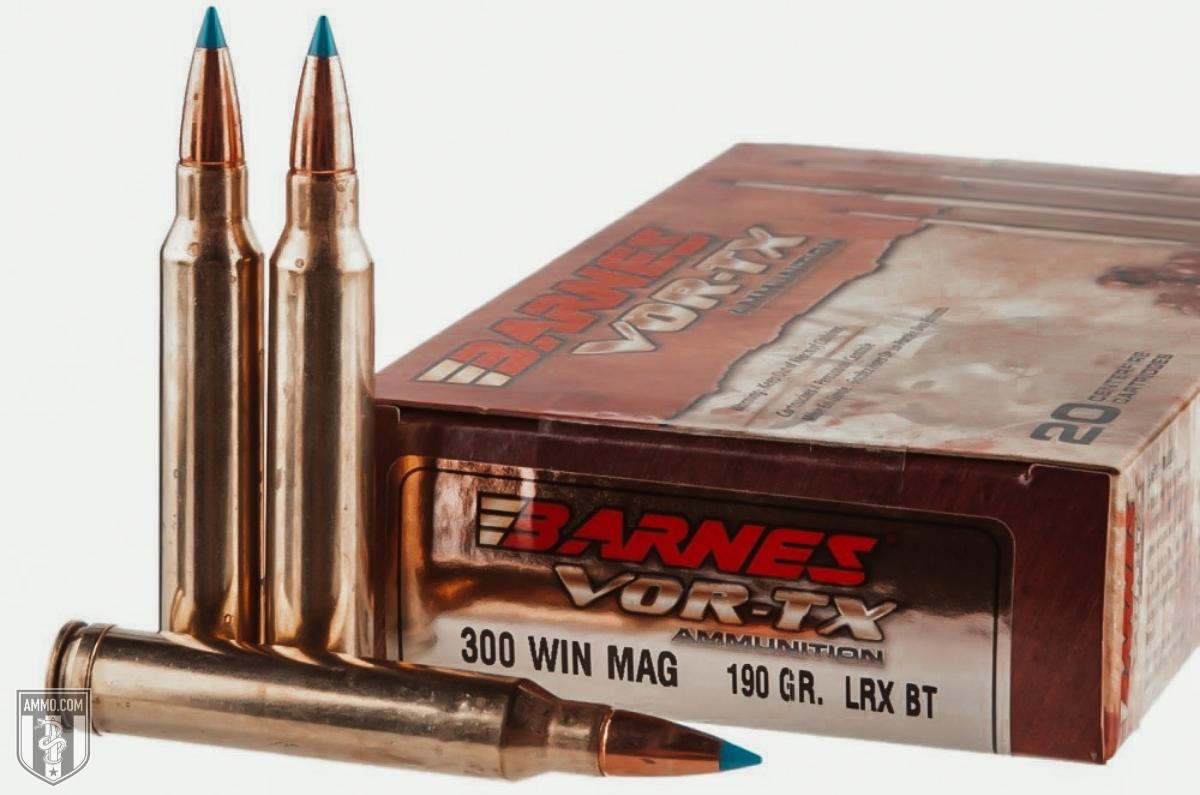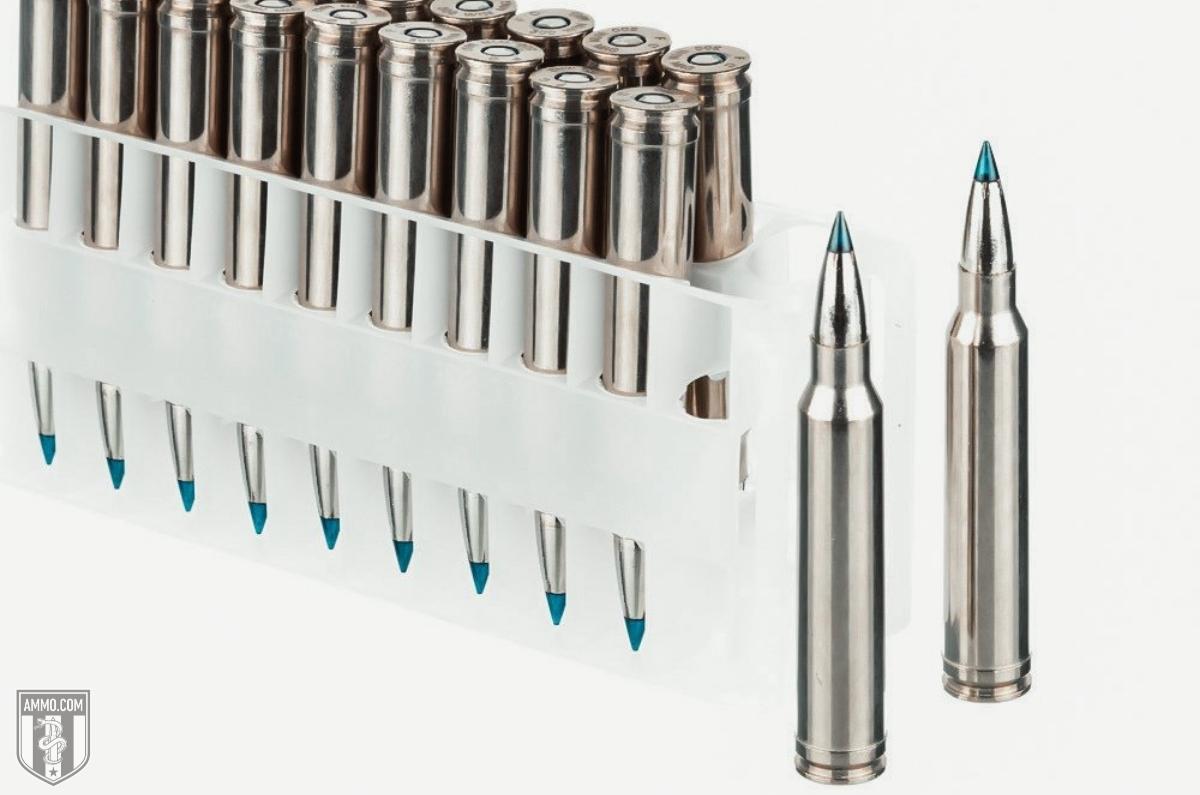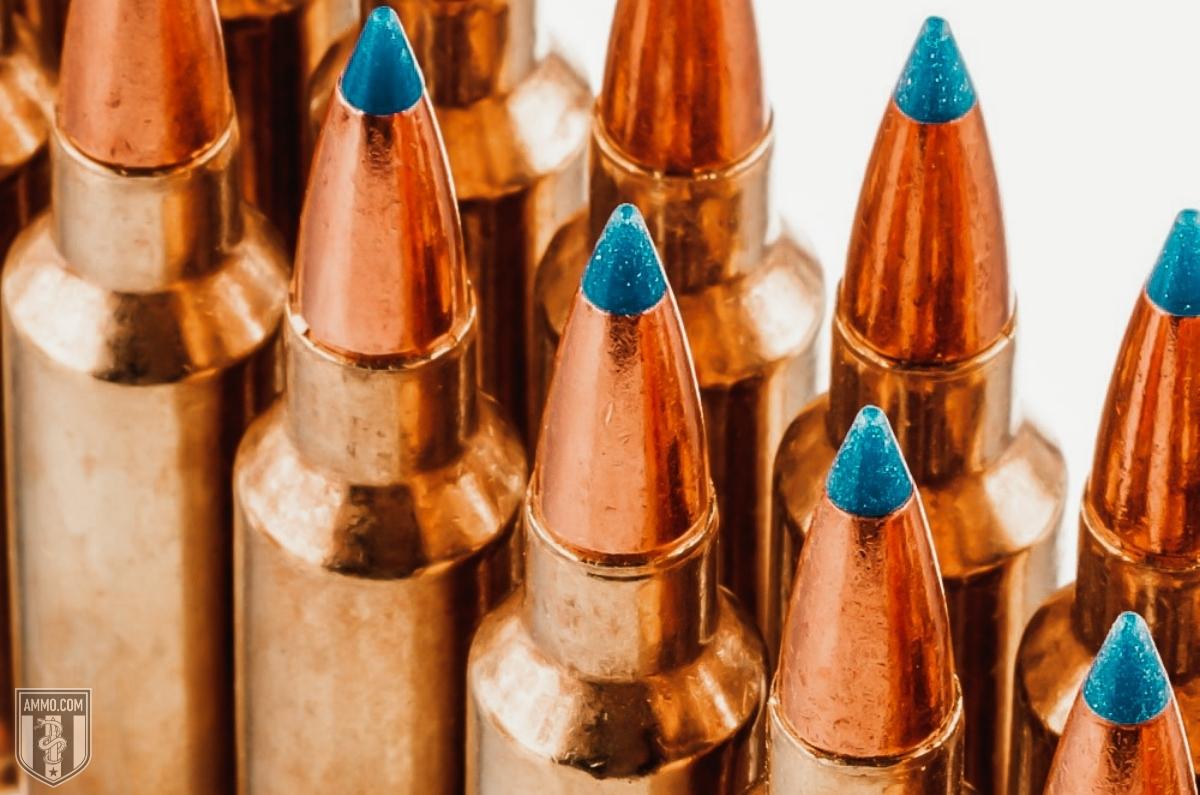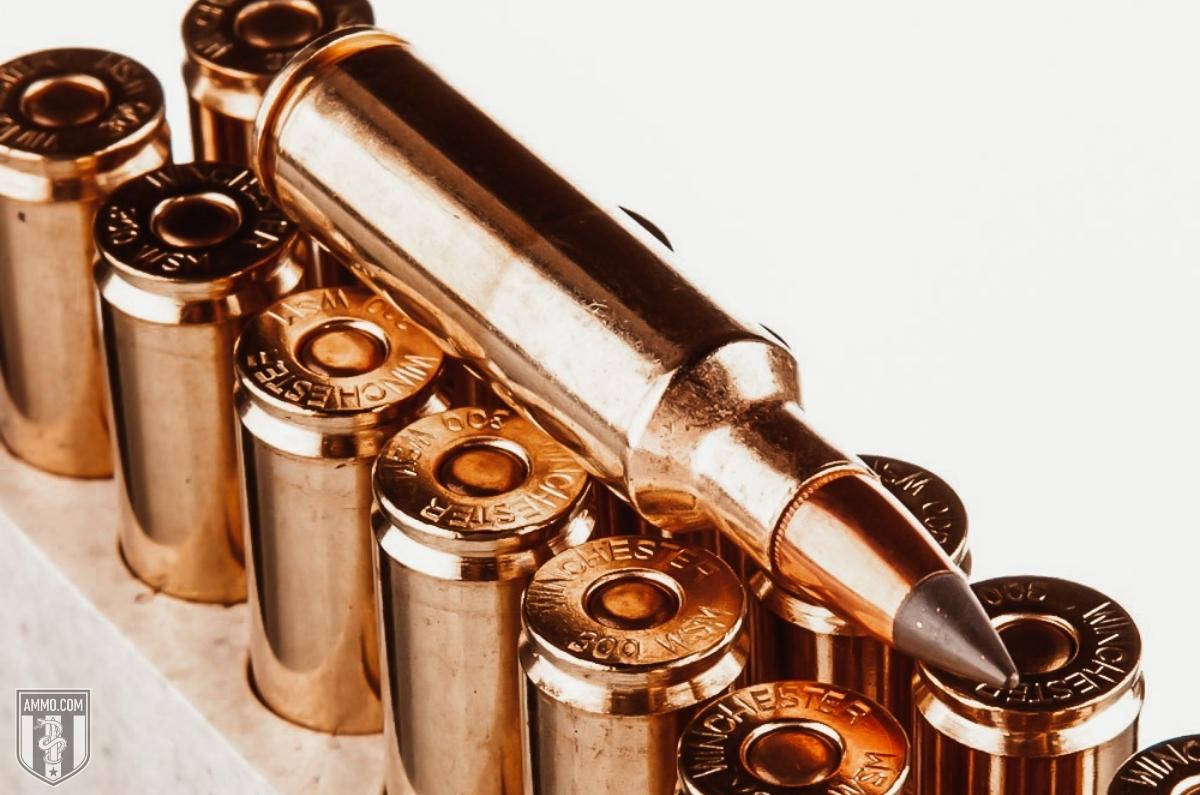300 WSM vs 300 Win Mag: The 30-Caliber Magnum Clash
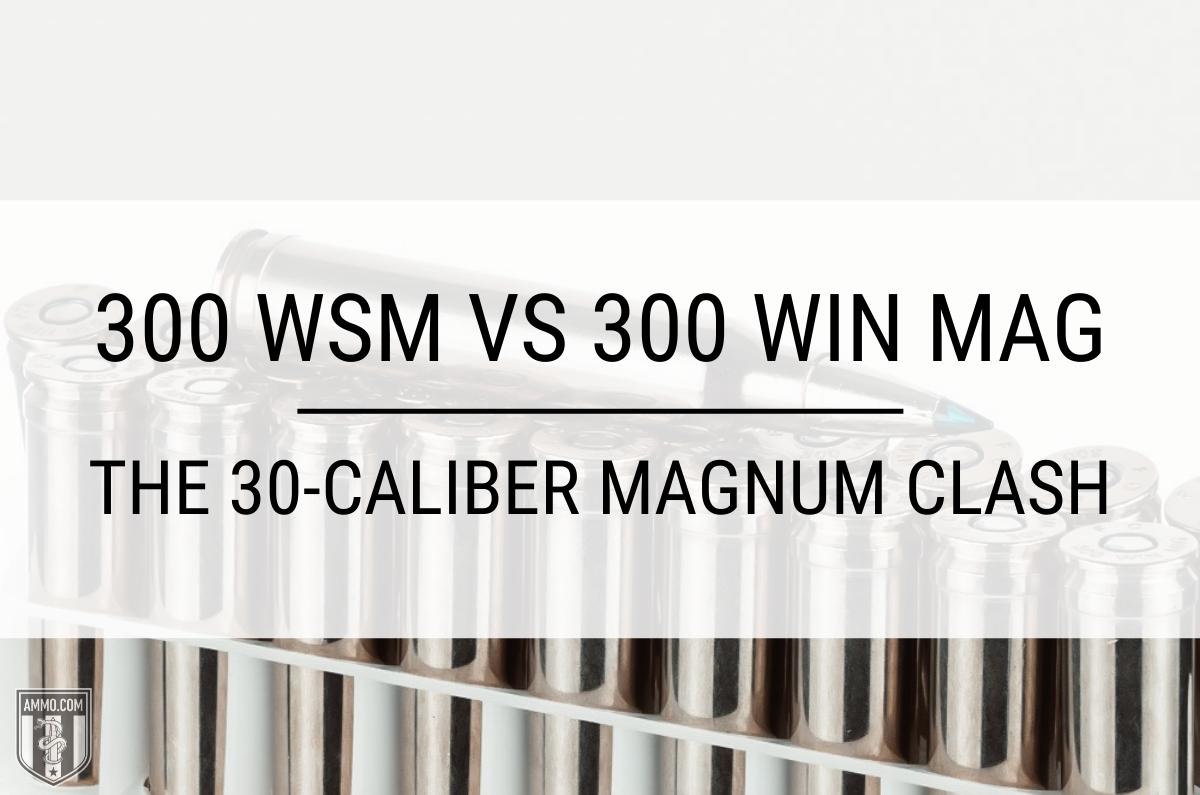 I was once perusing my local gun forum and someone posted a question, “Which is better for big game hunting in North America? 300 Win Mag or 300 WSM?” The users who answered all began debating differences in ballistics, case capacity, terminal performance, and ammo selection.
I was once perusing my local gun forum and someone posted a question, “Which is better for big game hunting in North America? 300 Win Mag or 300 WSM?” The users who answered all began debating differences in ballistics, case capacity, terminal performance, and ammo selection.
However, I’d like to pose a simpler answer: Yes!
The truth is that both rifle cartridges are more than sufficient to take down any whitetail, mule deer, feral hogs, elk, moose, caribou, or bear you set your sights on. Although there are minor differences in the ballistics of each, it’s unlikely any game animal will be able to feel the difference.
The question comes down to which type of rifle action you prefer, as a 300 Win Mag fits in a standard length or long action receiver and the 300 WSM fits in a short action.
Although the differences between the two cartridges are slight, it’s a good idea to know them so you know which 30-caliber magnum you want your new hunting rifle chambered in.
What Is the Difference Between 300 WSM and 300 Win Mag?
The 300 Winchester Magnum has been around since the 1960’s and has been a favorite for military snipers, big game hunters, and benchrest shooters alike. It is truly in contention for the title of America’s Favorite Magnum Cartridge and is the gold standard by which all belted magnum cartridges are measured.
The 300 Winchester Short Magnum (WSM) is a relative newcomer to the shooting community being released in 2001. The 300 WSM embodies the ballistic advantages of the 300 Win Mag and crams them into a short action rifle.
The result is a lighter rifle with identical barrel length and extremely similar external ballistics. Having a shorter, more maneuverable rifle can be extremely handy when elk hunting in thick brush.
Both rifle cartridges are extremely accurate and can easily achieve MOA to sub-MOA level accuracy with match grade factory loads or properly tuned handloads.
Although both cartridges are excellent for hunting or target shooting, they are not without their disadvantages.
Some detractors of the 300 WSM will point to its rebated rim, claiming that this might inhibit the ability of the bolt to push the cartridge from the magazine into the chamber. The 300 WSM’s steep 35-degree shoulders also play a part in this critique, as some forum users theorize that the sharp angle might hinder smooth feeding into the chamber.
Although I will say that feeding a 300 WSM is not as smooth as the experience with other cartridges, I’ve yet to experience a jam.
For the 300 Winchester Magnum, most of the complaints center around the useless belt on the cartridge case. As you’ll learn later in the history of the 300 Win Mag, the belted case is an artifact from the parent 375 H&H Magnum case.
Early rifles used the belt for headspacing, which caused premature case stretching and thereby reduced the lifespan of the brass. If all you shoot is factory ammo and you aren’t into reloading, this is a non-issue. However, for handloaders it’s a serious problem as it means you will have to replace your 300 Win Mag brass more frequently.
Many 300 Win Mag rifles now have their chambers reamed to headspace off the case shoulders, which eliminates premature case stretching entirely.
The last strike against the 300 Win Mag is the painfully short case neck. Some long range target shooting gurus state that the 300 Win Mag’s neck is not long enough to securely hold the projectiles and maintain concentricity. In theory, this could cause the bullet to enter the rifling off-axis and affect point of impact for long distance shots.
However, based on the lack of complaints by military snipers who routinely shoot well past 1000 yards with a 300 Win Mag, I’m guessing this critique is more an online forum talking point as opposed to a real-world issue.
In the following sections, we will analyze the 300 WSM vs 300 Win Mag in detail so you can understand the differences between these two rifle cartridges.
Cartridge Specs
When evaluating two big game hunting cartridges, it’s a good idea to analyze the cartridge specs to gain more knowledge of each.
The first, and most obvious, similarity is that both the 300 Win Mag and 300 WSM fire the same 0.308” caliber bullets. However, this is where the similarities end.
The 300 WSM is a good half inch shorter than the 300 Win Mag in terms of case length and overall length. This means that the 300 Win Mag will fit into a long action while the 300 WSM will fit in a short action.
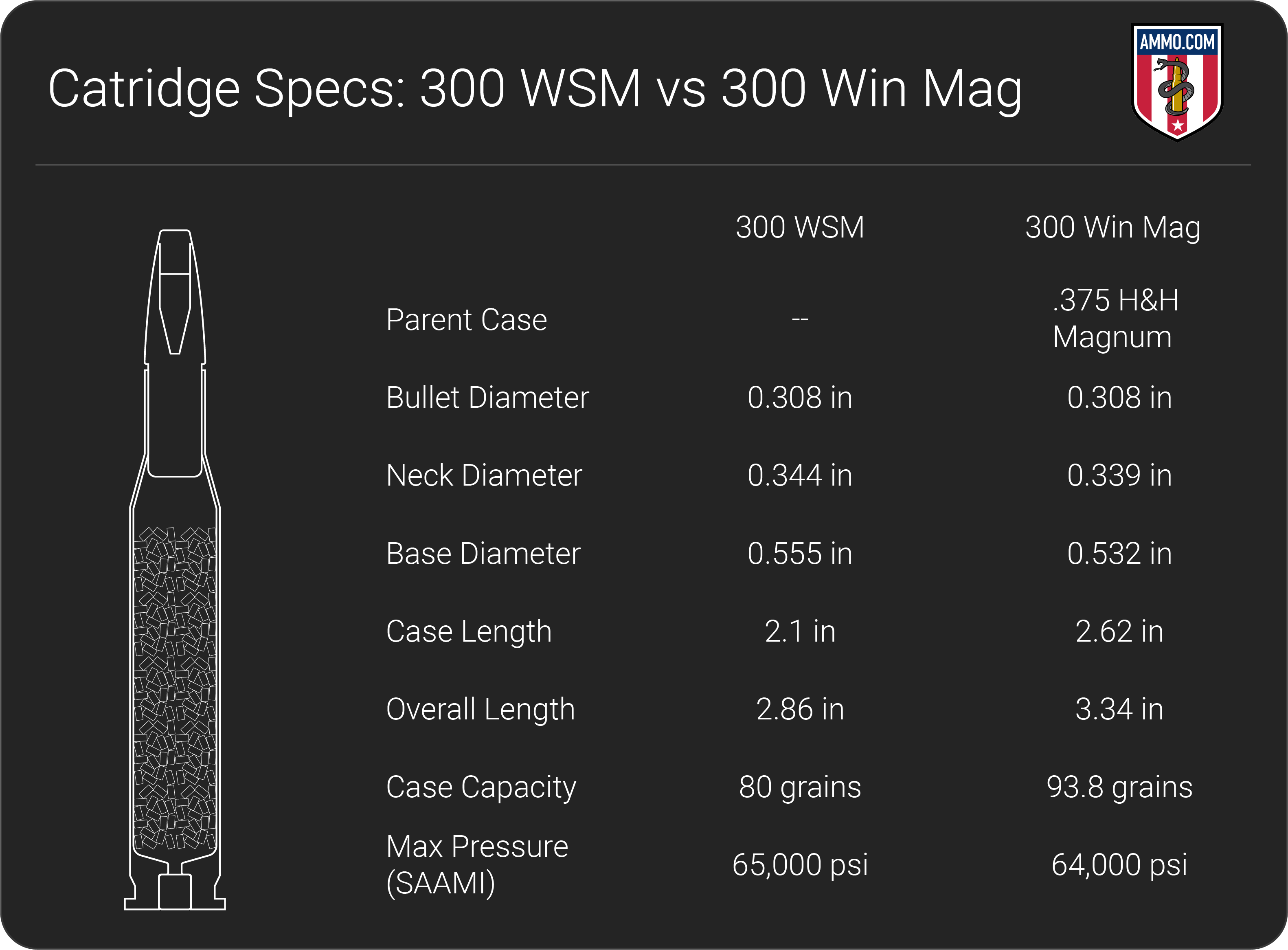
However, the base diameter of the 300 WSM is 0.02” wider than the 300 Win Mag. The wider base allows more powder to be loaded into the considerably shorter cartridge, meaning that there is about 10% less powder capacity for the 300 WSM compared to the 300 Win Mag.
However, the 300 WSM is rated to handle 1,000 more PSI of pressure based on SAAMI specs. So how is it that a cartridge with 10% less case capacity is capable of higher muzzle velocities than the larger cartridge?
The answer is simple: Efficiency
Since the 300 WSM is a shorter, fatter cartridge, this means that the powder column will be closer to the ignition source (the primer). As such, this creates an extremely efficient powder burn that leaves very little (if any) unburnt powder in the case or barrel. The 35-degree case shoulder also aids in a clean powder burn.
The 300 Win Mag is not an inefficient cartridge, the 300 WSM just does it a little bit better. With all of this in mind, let’s see how it affects the external ballistics of both cartridges.
Recoil
Recoil is the energy directed towards the shooter when a cartridge is fired from a firearm. For experienced hunters or marksmen, recoil will be a non-issue. However, for less experienced shooters or those who are recoil sensitive, less felt recoil will be preferred.
Lower recoil will also allow shooters to get their sights back on target quicker for follow-up shots. In contrast, heavy recoil can cause shooters to flinch before they pull the trigger, and during long-range shooting sessions, shoulder fatigue can become an issue.
The 300 Winchester Magnum is well known for having stout recoil, and many shooters will opt for a good recoil pad or muzzle brake to make shooting the 300 Win Mag more enjoyable. But how does it compare to the 300 Winchester Short Magnum?
The 300 WSM will fire the same bullet weights as the 300 Win Mag, so the only factor that will play a role in recoil is the powder charge being used. As the 300 Win Mag has about 10% more case capacity, it will have more felt recoil on average than the 300 WSM.
However, the difference is only slight as the average recoil for the 300 Win Mag clocks in at 28 ft-lbs of shoulder punishment while the 300 WSM has on average 25 ft-lbs of recoil energy. Just like case capacity, there is about a 10% decrease in felt recoil when you switch from 300 Win Mag to the 300 WSM.
To be honest, 3 ft-lbs difference is not all that much. It’s nothing like the difference between 308 Winchester and 223 Remington! But it’s also not nothing either.
If a shooter is recoil sensitive, then the 300 WSM is the better choice as it has less recoil than the 300 Win Mag.
Trajectory
Trajectory is how we quantify a bullet’s flight path as it travels downrange measured in inches of bullet drop.
Obviously, a flatter shooting cartridge is preferred for shooting longer ranges, as a shooter will require fewer adjustments to their optics to compensate for bullet drop. Having a flatter trajectory also means that a cartridge will be more forgiving of ranging mistakes.
For this comparison, we will consider the 180 grain bullets from the Nosler Accubond line, as this is an extremely popular hunting round.
Looking at the ballistics tables below, you’ll note that the bullet drop for 300 Win Short Mag at 400 yards is -17.2” while the 300 Win Mag has dropped -18.5”. Using the Hornady ballistic calculator to extrapolate to a 1000-yard shot, the 300 WSM is at -287.1” and 300 Win Mag has experienced -298.7” of bullet drop.
The slightly faster 300 WSM traveling at a muzzle velocity of 3,010 FPS will reach the target just a little faster than the 300 Win Mag traveling at 2,960 FPS and this is the reason for the small discrepancy in trajectory.
Benchrest shooters might be able to tell the difference at 1,000 yards, but the vast majority of shooters will have a hard time detecting any difference in trajectory between the two (especially at normal hunting distances).
Ballistic Coefficient
Ballistic coefficient (BC) is a measure of how well a bullet resists wind drift and air resistance. Put another way, it’s a numeric representation of how aerodynamic a bullet is. A high BC is preferred as this means the bullet will buck the wind easier.
Generally, heavier bullets will have a higher BC as it takes more force to disrupt the flight of a heavier bullet than a lighter one. Ballistic coefficient varies from bullet to bullet based on design, weight, and other factors that are beyond the scope of this article.
As the 300 Win Mag and the 300 WSM fire the exact same caliber bullets, they will have identical SD’s provided the factory loads are similar between the two.
Sectional Density
Sectional Density (SD) is the measure of how well a bullet penetrates a target. This is extremely important when hunting big game, as you need a bullet that can punch through thick hide, bone, and sinew.
Sectional density is calculated by comparing the bullet weight and the bullet diameter. The higher the SD the deeper the bullet will penetrate into the target. This is a simplified view of penetration as there are other factors to consider, such as bullet expansion and velocity.
As the 300 Win Mag and 300 WSM are neck-and-neck when it comes to velocity, there is little to no detectable difference in penetration between the two rounds provided the same bullet is being fired from each.
Hunting
This is the question that gets asked most frequently in hunting forums and at gun store counters: Which is better for hunting big game? 300 WSM or 300 Win Mag?
Although I’d like to share with you some super-secret ballistic data that clearly shows one cartridge is superior to the other, sadly I can’t, because they are essentially identical.
The only caveat I have to this statement is that there is a wider range of factory ammo available for 300 Win Mag due to its longer time on the market. This gives you more options to find the type of ammo your rifle really likes the best, whereas with 300 WSM you have fewer options to choose from.
Other than this, there is little difference between 300 Winchester Magnum and the 300 WSM, so shoot whichever you like best and know that you have more than enough cartridge to go elk hunting or to head into bear country.
Ammo and Rifle Cost/Availability
As mentioned in the previous section, the 300 Win Mag has a greater breadth and depth of ammo varieties due to its age. For example, Federal Premium has over 20 different varieties of 300 Win Mag ammo listed on their website alone! All of the other major manufacturers like Hornady, Nosler, Barnes, and Berger and Federal also have extensive offerings for 300 Win Mag.
This is not to suggest that you will feel constricted in terms of factory ammo for 300 Win Short Mag, quite the contrary. There are plenty of options and bullet weights available for 300 WSM. However, the are about 2x more options for 300 Win Mag compared to 300 WSM.
In terms of ammo cost, as the 300 Win Mag will be lower as it is more widely used and is also a military and police cartridge.
Generally, 300 Win Mag ammo can run as low as $2/round for cheap FMJ practice ammo and about $4-5/round for the high-quality hunting factory loads.
For 300 Win Short Mag, the cheapest ammo I could find ran about $2.50/round for practice ammo and $5+ for hunting ammo.
The difference in price is not to the point that it would inhibit most shooters from picking the 300 WSM, but the widespread popularity of the 300 Win Mag has had a positive effect on the price (for the consumer).
For rifles, most offerings you’ll find from Remington, Ruger, Savage, and Sako will be the bolt action variety. However, if you want a semi-auto rifle, then the Browning BAR is your main option currently.
As far as cost is concerned, there will be virtually zero difference in price between a 300 WSM and 300 Win Mag when purchasing a new rifle.
The only major difference between 300 Win Mag and 300 WSM rifles will be their overall length.
As the 300 WSM requires a short action, it will typically be about a 1-1.5” shorter than a 300 Win Mag rifle. Both rifles utilize a 24 inch barrel, but since the 300 WSM uses a short action, it makes for a shorter overall rifle length.
Reloading
In terms of reloading, the 300 WSM and 300 Win Mag are excellent options as there is plenty of load data for both cartridges available. You’ll be purchasing the same 0.308” caliber bullets for both, which makes it easy to stock up.
In terms of powder selection, there are fewer suitable powders that have current load data for 300 WSM. However, there are powders like H414, H4350, and IMR 4451 that can be used for loading both cartridges.
Reloading is an excellent method to reduce your overall cost per round and create extremely accurate and consistent ammo that is tailored for your rifles.
Ballistics
Our team here at Ammo.com has spent countless hours scouring the Internet to bring you extremely comprehensive ballistics tables for both calibers. These tables will compare bullet weight to muzzle velocity, muzzle energy, and trajectory.
300 WSM Ballistics
| 300 Win Short Magnum Bullet WEIGHT | Muzzle VELOCITY (fps) | Muzzle ENERGY (ft. lbs.) | TRAJECTORY (in.) | |||||||||||
|---|---|---|---|---|---|---|---|---|---|---|---|---|---|---|
| Muzzle | 100 yds. | 200 yds. | 300 yds. | 400 yds. | Muzzle | 100 yds. | 200 yds. | 300 yds. | 400 yds. | 100 yds. | 200 yds. | 300 yds. | 400 yds. | |
| 150 Grain | 3300 | 3061 | 2834 | 2619 | 2414 | 3628 | 3121 | 2676 | 2285 | 1941 | 1.1 | 0 | -5.4 | -15.9 |
| 180 Grain | 2970 | 2741 | 2524 | 2317 | 2120 | 3526 | 3005 | 2547 | 2147 | 1797 | 1.6 | 0 | -7 | -20.5 |
| 180 Grain | 3010 | 2923 | 2734 | 2554 | 2380 | 3242 | 2845 | 2490 | 2172 | 1886 | 1.3 | 0 | -5.9 | -17.2 |
| 190 Grain | 2875 | 2729 | 2588 | 2451 | 2319 | 3486 | 3142 | 2826 | 2535 | 2269 | 0 | 3.2 | -11.5 | -25.7 |
300 Win Mag Ballistics
| 300 Win Magnum Bullet WEIGHT | Muzzle VELOCITY (fps) | Muzzle ENERGY (ft. lbs.) | TRAJECTORY (in.) | |||||||||||
|---|---|---|---|---|---|---|---|---|---|---|---|---|---|---|
| Muzzle | 100 yds. | 200 yds. | 300 yds. | 400 yds. | Muzzle | 100 yds. | 200 yds. | 300 yds. | 400 yds. | 100 yds. | 200 yds. | 300 yds. | 400 yds. | |
| 150 Grain | 3290 | 2951 | 2636 | 2342 | 2068 | 3605 | 2900 | 2314 | 1827 | 1424 | 2.5 | 1.9 | -3.8 | -15.8 |
| 150 Grain Superformance | 3400 | 3150 | 2914 | 2690 | 2477 | 3850 | 3304 | 2817 | 2409 | 2043 | 1 | 0 | -5.1 | -15 |
| 165 Grain | 3100 | 2877 | 2665 | 2462 | 2269 | 3522 | 3033 | 2603 | 2221 | 1897 | 2.5 | 2.4 | -3 | -16.9 |
| 178 Grain | 2900 | 2760 | 2568 | 2375 | 2191 | 3509 | 3030 | 2606 | 2230 | 1897 | 2.5 | 1.4 | -5 | -17.6 |
| 178 Grain | 2960 | 2770 | 2588 | 2413 | 2245 | 3463 | 3032 | 2647 | 2301 | 1992 | 1.5 | 0 | -6.7 | -19.4 |
| 178 Grain Super Match | 2960 | 2770 | 2587 | 2412 | 2243 | 3462 | 3031 | 2645 | 2298 | 1988 | 1.5 | 0 | -6.7 | -19.4 |
| 180 Grain | 2960 | 2745 | 2540 | 2344 | 2157 | 3501 | 3011 | 2578 | 2196 | 1859 | 2.5 | 1.2 | -5.5 | -18.5 |
| 180 Grain Superformance | 3130 | 2927 | 2732 | 2546 | 2366 | 3917 | 3424 | 2983 | 2589 | 2238 | 1.3 | 0 | -5.9 | -17.3 |
| 190 Grain | 2885 | 1691 | 2506 | 2327 | 2156 | 3511 | 3055 | 2648 | 2285 | 1961 | 2.5 | 1.2 | -5.7 | -19 |
| 200 Grain | 2825 | 2595 | 2376 | 2167 | 1970 | 3545 | 2991 | 2508 | 2086 | 1742 | -2.5 | 1.6 | -4.7 | -17.2 |
| 220 Grain | 2680 | 2448 | 2228 | 2020 | 1823 | 3508 | 2927 | 2424 | 1993 | 1623 | 2.5 | 0 | -9.5 | -27.5 |
A Brief History of the 300 WSM
In 2001, Winchester released a new rebated rim cartridge called the 300 Winchester Short Magnum.
Also known as the 300 Win Short Mag or 300 WSM, it was a cartridge designed with North American hunters in mind. Capable of being fired in a short action rifle, the 300 WSM offered hunters a light rifle with magnum ballistics.
The 300 WSM was inspired by the 404 Jeffrey cartridge, a classic hunting round with a heritage of taking down Kodiak bears and the African Big 5. However, the 300 WSM is a unique design specifically calibrated to handle magnum-level pressures without the use of a belted case.
The 300 WSM was developed to mimic the performance of the 300 Win Mag in a smaller package that could be used in a short action rifle.
Popular bullet weights for the 300 WSM range between 150 and 190 grains, with the most popular factory loads being of the 150, 165, and 180 grain variety.
Capable of claiming any game animal on the North American continent, the 300 WSM has solidified its position as an excellent alternative to hunters who want magnum power in a compact, light weight package.
A Brief History of the 300 Win Mag
In 1963, Winchester introduced the 300 Win Mag in its long-action Winchester Model 70 bolt action rifle.
Remington quickly followed suit, introducing a 300 Win Mag offering in its popular Rem 700 bolt action rife. Since then, the 300 Winchester Magnum has quickly become one of the most successful magnum rifle cartridges on the market today.
The 300 Winchester Magnum was developed from the belted 375 H&H Magnum cartridge and sports a whopping case capacity of 91.5 gr of water and a max pressure of 64,000 psi based on SAAMI specifications.
This voluminous case capacity allows the 300 Win Mag to pack in the powder and push the .308” diameter bullet to its limits.
At the muzzle, a 150-grain bullet is screaming down range at about 3300 fps with a back-breaking 3600 ft-lbs of energy. That is some serious power! Standard loadings for the 300 Win Mag range between bullet weights of 150 and 220 gr.
Many shooters believe that the belted case is required to contain the “case-splitting” pressure that the 300 Win Mag must exude. However, this is a common misconception.
Based on the case design, the belted cartridge is superfluous. However, Winchester retained the designed as a marketing strategy to link the cartridge to its heavy hitting predecessor, the 375 H&H Magnum.
The strategy was wildly successful as the 300 Winchester Magnum has become one of the most popular magnum cartridges on the market, surpassing the 7mm Rem Mag and 270 Weatherby Magnum.
Final Shots: 300 Win Mag vs 300 WSM
The 300 WSM and 300 Win Mag are two extremely potent long range shooting cartridges that are beloved by hunters and benchrest shooters alike. They are both extremely accurate and can take down any big game animal North America can throw at you.
The 300 Winchester Magnum has been the gold standard by which all other magnum sporting rounds are measured for over half a century. It is the long range rifle cartridge of choice for US military snipers and is easily capable of hitting targets at over 1,000 yards.
The 300 Winchester Short Magnum is a newcomer to the sporting cartridge world, just being released in 2001. It mimics the external ballistics of the 300 Win Mag and is capable of being used in a short action rifle, making it an excellent choice for hunters and sportsmen who want a lighter rifle for treks into heavy bush.
However, if the 300 WSM offers only minimal ballistic advantages over the 300 Win Mag, what’s the point of the round?
The answer is simple: Shooters like options.
Some marksmen want that standard length action and the rigidity it provides as a shooting platform. While other sportsmen want a light weight option to make stalking that trophy elk or moose an easier task.
The truth is, you cannot go wrong with either cartridge. Both will serve you well so long as your shot placement is on point, then there is no game animal that will stand up to a shot from either a 300 Win Mag or a 300 WSM.
Ammo Comparisons
- .308 vs 5.56
- 6.5 Creedmoor vs .308
- .300 Blackout vs .308
- .300 Win Mag vs .308
- .243 vs .308
- .308 vs .30-06
- 7mm-08 vs .308
- .270 vs .308
- 7.62x39 vs .308
- .223 vs .308
- .338 Lapua vs .308
- .380 ACP vs 9mm
- .223 vs 5.56
- .300 Blackout vs 5.56
- 9mm vs 45 ACP
- 9mm vs 40 S&W
- .357 SIG vs 9mm
- 10mm vs 9mm
- 9mm vs 9mm Luger
- .243 vs .270
- .300 Win Mag vs .30-06
- .270 vs .30-06
- .40 vs .45
- 38 Special vs 357
- 9mm vs 40 vs 45
- 5.56 vs 7.62x39
- 338 Lapua vs .30-06
- .30-30 vs .30-06
- 300 PRC vs 338 Lapua
- .30-06 vs 7mm
- 300 Win Mag vs 338 Lapua
- 300 PRC vs 300 Win Mag
- 300 WSM vs 300 Win Mag
- 338 Win Mag vs 338 Lapua
- 12 Gauge vs 20 Gauge
- 10mm vs 357 Mag
- .30-30 vs 7.62x39
- 224 Valkyrie vs 22-250
- 17 HMR vs 22 Mag
- 7.62x39 vs .300 Blackout
- 45 ACP vs 45 Auto
- 45-70 vs 30-30
- 300 Blackout vs 223
- 357 Magnum vs 9mm
- 350 Legend vs 300 Blackout
- 224 Valkyrie vs 223
- 45 ACP vs 38 Super
- 6.5 Grendel vs .308
- 17 HMR vs 22 LR
- 10 Gauge vs 12 Gauge
- 22-250 vs 223
- 45 Colt vs 45 ACP
- 350 Legend vs 30-30
- 5.7x28 vs 223
- 5.7 vs 9mm
- 5.56 vs 5.7
- 22 vs 9mm
- Buckshot vs Birdshot
- 450 Bushmaster vs 308
- 450 Bushmaster vs 223
- Buckshot vs Slug
- 6.5 Grendel vs 5.56 vs 223
- 6mm ARC vs 6.5 Grendel
- 44 vs 45
- 458 SOCOM vs 5.56
- 357 vs 44
- 32 ACP vs 380
- 300 Win Mag vs 338 Win Mag vs 338 Lapua Mag
- 450 Bushmaster vs 458 SOCOM vs 50 Beowulf
- 6mm Creedmoor vs 6.5 Creedmoor
- TMJ vs FMJ
- 44 Special Vs 44 Magnum
- 45 90 vs 45 70
- 6.8 Western vs 6.8 SPC
- 50 Beowulf vs 50 BMG
- 26 Nosler vs 6.5 PRC
- 28 Gauge vs 410
- 6.8 SPC vs 5.56
- 6.8 SPC vs 6.5 Grendel
- 6.8 Western vs 7mm Rem Mag vs .28 Nosler
- 6.8 Western vs 6.5 Creedmoor
- 22 Hornet vs 223
- 6.8 Western vs 6.5 PRC
- .410 vs 12 Gauge
- .410 vs 20 Gauge
- 22 LR vs 22 Mag
- 6mm ARC vs 243
- 7mm-08 vs 270
- 243 vs 6.5 Creedmoor
- Nickel vs Brass Casing
- 204 Ruger vs 223
- 50 Beowulf vs 5.56
- 260 Remington vs 6.5 Creedmoor
- 6mm Remington vs 243
- 28 Nosler vs 300 PRC
- 50 Beowulf vs 50 AE
- 22 Nosler vs 22-250
- 450 Marlin vs 45-70
- 300 Win Mag vs 300 Norma
- 458 SOCOM vs 300 Blackout
- 38-55 vs 45-70
- 22 Hornet vs 22 LR
- 300 Norma vs 338 Lapua
- 338 Lapua vs 50 BMG
- 28 Nosler vs 300 Win Mag
- 28 Nosler vs 6.5 Creedmoor
- 204 vs 22-250
- 458 SOCOM vs 45 70
- 44 40 vs 45 70
- 6.8 SPC vs 6.5 Creedmoor
- 450 Bushmaster vs 30-06
- 7mm Rem Mag vs 300 Win Mag
- 30 Carbine vs 223
- 25-06 vs 30-06
- 26 Nosler vs 28 Nosler
- 16ga vs 12ga
- 30 06 vs 7.62 x54R
- 9mm Makarov vs 9mm Luger
- 350 Legend vs 223
- 30 Carbine vs 5.56
- 6.5x55 vs 6.5 Creedmoor
- 6.5 Creedmoor vs 270 vs 25-06
- M193 vs M855
- 450 Bushmaster vs 458 SOCOM
- 6.5 Grendel vs 6.5 Creedmoor
- 350 Legend vs 5.56
- .277 Fury vs 6.8 SPC
- 277 Fury vs 300 Win Mag
- 10mm vs .45 ACP
- 277 Fury vs 223
- 6.8 SPC vs 300 Blackout
- 6.5 PRC vs 6.5 Creedmoor
- 277 Fury vs 308
- 277 Fury vs 6.5 Creedmoor
- 350 Legend vs 450 Bushmaster
- 277 Fury Vs 5.56 NATO
- 10mm vs 40S&W
- 32 ACP vs 9mm
- 32 Special vs 9mm
- 8.6 Blackout vs 300 Blackout
- 30 Super Carry vs. 9mm
- 5.56 vs 9mm
- .50 Action Express vs 9mm
- 7.62x25 vs. 9mm
- 10mm vs 44 Magnum
- 300 Blackout vs 300 Win Mag
- 6.5 Grendel vs 300 Blackout
- 460 Rowland vs 10mm
- 300 RUM vs 300 PRC
- 300 Norma vs 300 PRC
- 45 GAP vs 45 ACP
- 7mm PRC vs 300 Win Mag
- 300 PRC vs 6.5 Creedmoor
- 300 PRC vs 308
- 357 SIG vs 357 Mag
- 7.62x39 vs 7.62x51
- 243 Win vs 223 Rem
- 30 Nosler vs 300 PRC
- 6.5 Creedmoor vs. 30-06 Springfield
- 450 S&W vs. 44 Magnum
- 6.5 Creedmoor vs. 300 Win Mag
- 454 Cassull vs. 45-70 Govt
- 454 Cassull vs. 44 Mag
- 7.62x54r vs. 308 Winchester
- 22 ARC vs. 223 Rem
- Subsonic vs. Supersonic Ammo

